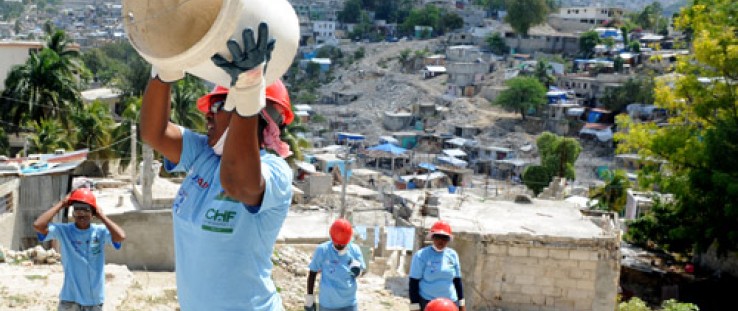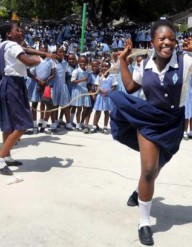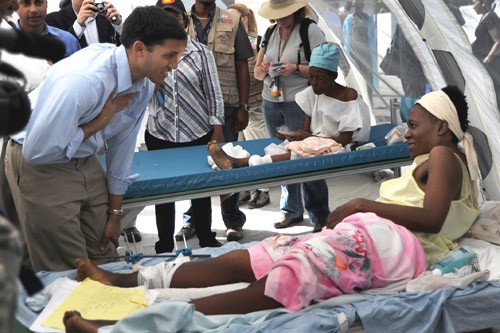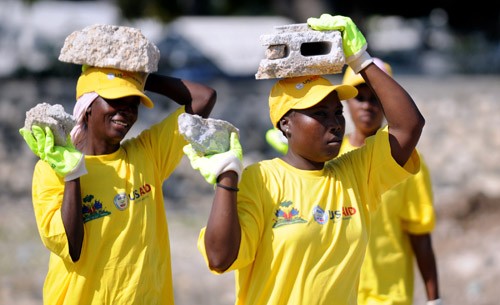 A woman catches a bucket in a line for rubble removal in the hilly Ravine Pintade neighborhood in Port-au-Prince, Haiti, Feb. 16, 2011. About 75 percent of the neighborhood's structures were destroyed in the earthquake.
Kendra Helmer, USAID
A woman catches a bucket in a line for rubble removal in the hilly Ravine Pintade neighborhood in Port-au-Prince, Haiti, Feb. 16, 2011. About 75 percent of the neighborhood's structures were destroyed in the earthquake.
Kendra Helmer, USAID
 A woman catches a bucket in a line for rubble removal in the hilly Ravine Pintade neighborhood in Port-au-Prince, Haiti, Feb. 16, 2011. About 75 percent of the neighborhood's structures were destroyed in the earthquake.
Kendra Helmer, USAID
A woman catches a bucket in a line for rubble removal in the hilly Ravine Pintade neighborhood in Port-au-Prince, Haiti, Feb. 16, 2011. About 75 percent of the neighborhood's structures were destroyed in the earthquake.
Kendra Helmer, USAID
Haiti is one of the U.S. government's critical priority countries, if not in terms of possessing an official "CPC" designation, then surely in terms of scope of U.S. government commitment. The special status is not unfounded. The Caribbean nation is rounding the corner on a year marred by a trio of disasters.
The fateful run of bad fortune began on Jan. 12, 2010, when an earthquake with an epicenter near Port-au-Prince took the lives of 230,000 people, and left an estimated 10 million cubic meters of rubble. In the months following the earthquake, a hurricane lashed Haiti's western coast and a cholera outbreak spread throughout the country.
Most Americans know that Haitians are poor and recovery is progressing slowly, but the full story is much more complicated. It's one of old struggles, new challenges, U.S. commitment, and hope.
The earthquake brought global attention to Haiti's hardship, but it didn't bring poverty. Even before the quake, Haiti was the poorest country in the Western Hemisphere, with most Haitians living on less than a dollar a day. Eighty percent were unemployed and half were illiterate. The country's statistics for governance, health, and economic growth followed the same depressing trend.
The earthquake, however, turned a dire situation into a desperate one. For many Haitians, it took their homes, it took their jobs, it took their lives.
"Words can't do justice to the earthquake's destruction," said USAID/Haiti Mission Director Carleene Dei. "Some neighborhoods were so badly damaged, it's impossible to tell what they looked like before the earthquake."
One year later, the situation appears almost as bad as it did during the immediate aftermath of the earthquake. Most of the rubble remains unmoved. Over a million Haitians live in the tents that cover almost every inch of public space in Port-au-Prince. Perhaps worst of all, cholera continues to take lives and cause illness. Progress toward reconstruction is moving slowly.
Despite the challenges that persist, the international community, especially the U.S. government and the American people, has rallied to support Haiti. The U.S. government spent over $1.16 billion and saved countless lives during the earthquake response. That money fed more than 3.5 million people, provided Haitians with 800,000 mosquito nets to protect against malaria, immunized a million Haitians against common diseases, and increased access to safe drinking water above pre-earthquake levels.
"Stories that do not get written"
Mark Feierstein, assistant administrator for the Bureau for Latin America and the Caribbean, considers the response a success, even though serious challenges linger a year after the earthquake.
"The success of the U.S. government's response is measured in the tragedies averted, and in the stories that do not get written," Feierstein said.
The initial relief phase brought relative stability to Haiti and laid the groundwork for the long road to reconstruction. Signs of progress are beginning to emerge.
"We're already seeing results from our investments in agriculture," said Feierstein. "Haitian farmers participating in our watershed program increased food production by an average of 75 percent in the spring 2010 planting season."
In most developing countries, progress moves slowly after disasters. Haiti will be no exception, and the rebuilding effort could take even longer than it has in other post-disaster scenarios. Because Haiti was among the poorest countries in the world before this surge of disasters and the damage from the disasters was so great, a reconstruction effort of this magnitude is unprecedented.
Because the goal of reconstruction is to build a better Haiti than the one that existed before the earthquake, U.S. investments are targeting four priorities: economic growth, infrastructure, health and other basic services, and governance.
The Haitian government is leading the reconstruction effort. Any progress made with the help of the U.S. and international community will only be sustained through strong leadership by the Haitian government.
But perhaps the strongest asset is the country's people. It is the Haitians themselves who are making progress toward reconstruction. Despite the daunting challenges, they are learning new farming techniques that boost their food production, and they are removing rubble by hand. Haitians may, in fact, prove to be the most resilient people on earth.











Comment
Make a general inquiry or suggest an improvement.